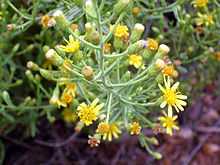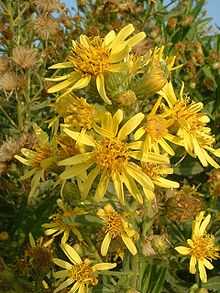Dittrichia viscosa
| Dittrichia viscosa | |
|---|---|
 | |
| Scientific classification | |
| Kingdom: | Plantae |
| (unranked): | Angiosperms |
| (unranked): | Eudicots |
| (unranked): | Asterids |
| Order: | Asterales |
| Family: | Asteraceae |
| Subfamily: | Asteroideae |
| Tribe: | Inuleae |
| Genus: | Dittrichia |
| Species: | D. viscosa |
| Binomial name | |
| Dittrichia viscosa (L.) Greuter, 1973 | |
| Synonyms | |
| |
Dittrichia viscosa, also known as False Yellowhead, Sticky Fleabane, Woody Fleabane and Yellow Fleabane, is a flowering plant in the daisy family.
This perennial plant is common throughout the Mediterranean Basin. Originally it was found mainly in dry riverbeds and abandoned fields up to a height of 1.500 m. Nowadays it is quite common in roadsides and ruderal habitats, even in urban areas. It is considered an invasive species in Australia.[1] The False Yellowhead is a tough plant, very resistant to adverse conditions and degraded environments. It is important as food for the caterpillars of certain butterflies and moths, like Ioana iolas.[2]
Despite the fresh-looking green color of its leaves and its attractive inflorescence,[3] this plant is sticky and has a certain smell that most people find unpleasant. It contains an essential oil[4] and has been used in traditional medicine since ancient times, especially in the Levant, as an astringent.[5]
It is an important plant in Catalan tradition, often mentioned in adages and proverbs. One adage says that: "els raïms són madurs quan floreixen les olivardes.", the grapes are ripe when the Yellow Fleabane blooms.
Gallery
-

Dittrichia viscosa habitus
-

Seed heads
-

Dittrichia viscosa. Flowers
-

Leaves
-
Utetheisa pulchella on Dittrichia viscosa
-

Ruderal community of Dittrichia viscosa growing on the railway-side gravel next to Petah Tikva-Sgula railway station, Israel.
-

Cipselae in situ
See also
References
External links
| Wikimedia Commons has media related to Dittrichia viscosa. |
| Wikispecies has information related to: Dittrichia viscosa |